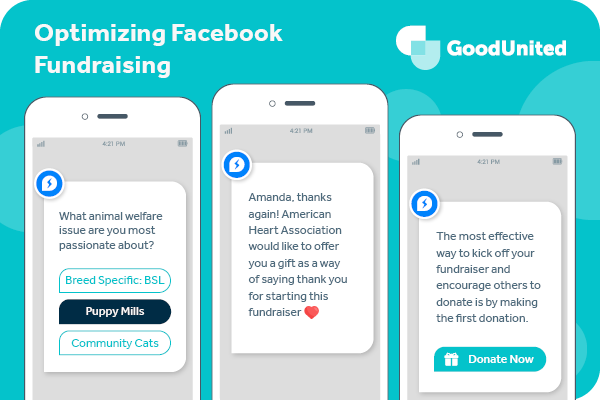If you’re running on a tight staff, you may be wondering whether Facebook fundraising is an effective use of your team’s time. Today, Nick Black, CEO of GoodUnited, is writing about how to utilize social media fundraising effectively to connect with donors and reach your goals.
If you search the term “Facebook fundraising” on Google, you’ll find informative articles about how to use the platform’s fundraising tools. However, you’ll also find opinion pieces about how the platform isn’t a worthwhile investment of staff time for nonprofits to make.
Some of these arguments are based on the fact that Facebook doesn’t provide a significant amount of donor data due to the platform’s privacy agreements. Others argue that the platform isn’t an effective channel for building relationships with supporters.
On the other hand, we’d argue that Facebook fundraising is well worth your staff’s time and energy. Even further, organizations that aren’t seeing a great return on their efforts haven’t been using the platform to its fullest potential.
At GoodUnited, we specialize in helping nonprofit organizations raise their relationships with their supporters using Facebook’s fundraising tools. Through that work, we’ve discovered strategies that nonprofits can use to help staff members use their time on the platform more effectively and build stronger connections with each individual supporter.
We’ll discuss this topic in depth through the following points:
- Examining Your Current Facebook Fundraising Strategy
- 3 Ways to Elevate Your Nonprofit’s Facebook Fundraising Strategy
Before we explore the ways that you can elevate your nonprofit’s Facebook fundraising strategy, let’s first discuss how many nonprofits have used the platform in the past. Then, we’ll discuss where many nonprofits are heading with Facebook fundraising— a strategy that’s both more efficient and effective when it comes to your staff’s time and the return on investment.
Let’s dive in.
Examining Your Current Facebook Fundraising Strategy
If you’re like most mid-sized nonprofit organizations, your Facebook fundraising strategy likely includes some combination of the following:
- Regularly posting on Facebook with information about upcoming opportunities for supporters to engage. You can also share updates about the outcomes of past fundraisers to demonstrate the value of your organization.
- Some minor promotion of Facebook fundraising as a way to get involved, such as briefly mentioning that supporters can start birthday fundraisers on the platform within your weekly newsletter.
- The use of Facebook as a platform to encourage users to visit your website and provide their information there to continue getting involved.
- The acceptance of Facebook fundraising as a minor, bonus fundraising channel rather than a legitimate revenue source— if a check comes in the mail or a direct deposit hits, it’s a useful addition, but not planned-for revenue.
For most nonprofits, Facebook fundraising is a more casual, user-led fundraising channel requiring little additional intervention from the organization itself. These organizations focus on more traditional social media strategies, building up an audience before sending that audience elsewhere (such as to their website) to continue engaging.
This traditional approach isn’t necessarily bad, but it’s far from the most efficient and effective way to use Facebook fundraising in your strategy. Let’s see why.
Problems with the Traditional Strategy
The strategy in the last section— a more casual approach to Facebook fundraising that involves little nonprofit intervention— comes with the following glaring obstacles:
- Supporters often fall through the cracks and receive little acknowledgment. Facebook doesn’t notify you that a supporter has started a fundraiser until they’ve already raised $50. This means that, unless you’re actively searching for them, you could miss out on thanking every supporter who doesn’t reach that threshold. You send thank-you letters to supporters in all other circumstances— you may even use templates to make sure these letters are perfect each and every time. Why wouldn’t you want to exercise the same gratitude for a social fundraising supporter?
- The strategy doesn’t result in sustainable fundraising. Instead, it results in quick, one-off revenue opportunities. Oftentimes, users who start Facebook fundraisers are new to the organization and cause that they’re raising funds for. Without a concentrated effort to engage these users for the long run, you’ll raise a few funds— but, you won’t retain them as supporters and grow your social audience over time.
- It assumes that users want to connect with your nonprofit through other channels. If a user starts a fundraiser on behalf of your nonprofit, that shows that they’re already comfortable and interested in engaging with your organization through Facebook. If they wanted to engage through email, another social network, or by phone, they’d reach out in that manner. So, why direct supporters to a different channel beyond one of their choice if you don’t need to?
- It doesn’t use Facebook itself as a true engagement channel and forces staff members to juggle multiple platforms to connect with supporters. When you send users to different channels to engage, those are just additional channels that your team needs to juggle for the success of your Facebook fundraising strategy.
What it comes down to is this: more traditional, stand-by Facebook fundraising strategies may be active, but they’re not proactive as far as leading to meaningful engagement with your supporters and ongoing growth for your fundraising strategy. So, what can you do instead to meet your engagement and fundraising goals on Facebook?
Where Facebook Fundraising for Nonprofits Is Heading
Facebook fundraising is evolving, with in-channel engagement taking center stage. Now, rather than using Facebook as a tool to build an audience, drive that audience to your other more “valuable” platforms, and maybe raise a few dollars in the process, the focus is on keeping supporters on the original platform and fostering relationships with them there.
Rather than using Facebook as a broadcasting device and simply sending out posts to your audience, shift your attention toward using the platform as a one-to-one communications tool. With Facebook, you can create online communities for segments of your audience, converse one-on-one with supporters, and even automate some of these efforts to save your team’s time.
When using Facebook fundraising in this manner, it functions as a prospect research tool, fundraising tool, and donor stewardship tool all in one social platform— allowing you to raise your relationships with the next generation of social supporters and build meaningful connections that last.
3 Ways to Elevate Your Nonprofit’s Facebook Fundraising Strategy
This new direction for how organizations use Facebook fundraising requires some flexibility and willingness to learn from your team. Let’s walk through three strategies you can use today to adjust your Facebook fundraising approach and place a focus on raising your relationships with social supporters in-channel.
One-to-One Messaging
Did you know that you can converse with your nonprofit’s supporters one-on-one through Facebook Messenger, just like you would with friends, family members, or colleagues?

In the above image, you can see some of the possibilities for using Facebook Messenger to connect with users who started fundraisers on your behalf, group members, or even simply those who follow your nonprofit’s Facebook page. With Messenger, you can share all of the following:
- Fundraising tips and encouragement for users who are in the middle of a social fundraising campaign.
- Information about your mission, nonprofit, and upcoming opportunities to engage.
- Gratitude and notes of appreciation throughout the year.
- Questions and links to external surveys to understand your supporters better.
The greatest perk of using Facebook Messenger to connect with supporters is that you can stay in touch with users who start fundraisers long after their campaigns end. Use the channel that they’ve already chosen to interact through— Facebook— and continue growing your relationships with them throughout the year.
This is inherently more efficient for your team, as you have a chance to retain the many supporters who start fundraisers on your behalf rather than losing them after a single campaign. But first, you need to invite supporters to connect through Facebook Messenger. One way to do this is through Facebook Groups.
Facebook Groups
The COVID-19 pandemic revealed many things about fundraising and nonprofit operations. For example, while many organizations found patchwork solutions to convert in-person events to become digital, the community built through in-person experiences is priceless and essential when it comes to creating a positive experience for supporters.
To emulate that, consider creating Facebook groups for segments of your audience— such as volunteers, advocates, users who start fundraisers, and users who are attending a virtual event.
According to this GoodUnited guide to virtual peer-to-peer fundraising, you can do all of the following from within Facebook groups:
- Empower supporters to connect with others who are interested in engaging with your nonprofit in similar ways
- Share fundraising tips and opportunities for supporters to participate in your offerings
- Monitor and contribute to the narrative surrounding your nonprofit, ensuring lively and on-brand conversation
In the last section, we focused on how you can foster connections with supporters one-on-one— but with groups, you can take that a step further and encourage supporters to forge a connection with one another, creating a greater community surrounding your mission.
Facebook Fundraising Solutions
The two strategies we’ve discussed so far make Facebook fundraising a more effective use of your team’s time, setting you up for growth in both relationships and funding over time. However, they also require additional tasks— using Messenger and managing groups— to be added to your team’s probably already-heavy workload.
If you’re interested in evolving your use of Facebook fundraising, but aren’t looking to add these additional tasks to your team’s lineup, consider working with a provider of Facebook fundraising solutions.
There are now turnkey social fundraising solutions that give your team the people, processes, and technology necessary to grow relationships with Facebook supporters at scale— from automated messaging sequences to full group management. With these services, you can remove the task of managing your nonprofit’s Facebook fundraising strategy from your team’s workloads, so staff members can focus on what really matters— connecting with supporters.
To wrap up, the future of Facebook fundraising requires a concentrated focus on building strong relationships with individual social supporters. With one-to-one messaging, Facebook groups, and even automated messaging solutions, your nonprofit will be able to scale up your efforts sustainably and raise your relationships through the platform. Good luck!
Thanks so much to Nick Black of GoodUnited for this excellent guest post. So many people already follow you on Facebook; so many more could – especially if you leverage your presence according to his strategic recommendations. It’s not easy, and requires effort, but that’s what it takes to build a strong, resilient, and sustainable financial base for your nonprofit!


